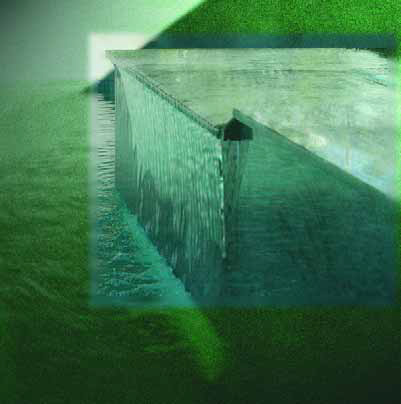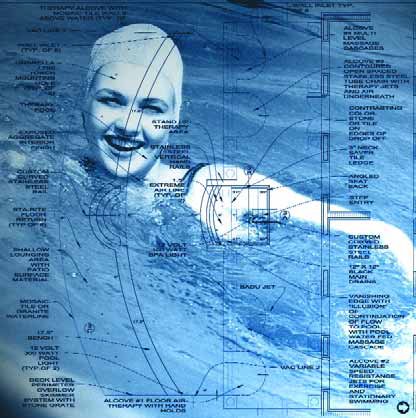materials
The Crown Fountain in Chicago's Millennium Park is an ingenious fusion of artistic vision and high-tech water effects in which sculptor Juame Plensa' s creative concepts were brought to life by an interdisciplinary team that included the waterfeature designers at Crystal Fountains. Here, Larry O'Hearn describes how the firm met the challenge and helped give Chicago's residents a defining landmark in glass, light, water and bright faces. In July last year, the city of Chicago unveiled its newest civic landmark: Millennium Park, a world-class artistic and architectural extravaganza in the heart of downtown. At a cost of more than $475 million and in a process that took more than six years to complete, the park transformed a lakefront space once marked by unsightly railroad tracks and ugly parking
Understanding the client is frequently the most important factor in creating a successful design. In the case of the project highlighted here, for example, it was a given that the clients were highly educated and knowledgeable with respect to design, style and materials: He's a top-flight graphic designer with an amazing grasp of color, line, architectural details, presentation materials and techniques; she's a degreed interior designer with a wonderful artistic flair. They're also two of my best friends: He and I taught together at UCLA and have known each other for more years than I care to admit. They've known about the focus of my business for years and said they hadn't wanted to call me because the project
One of the great things about working with different architects and designers the way we do is that, as builders of pools, spas and other watershapes, we enjoy opportunities to work across a broad range of design styles and sensibilities. In this instance, we're focusing on one of our favorite Southern California architects, Mark Singer. He's known regionally for crisp, clean, minimalist designs and is well regarded for his work on breathtaking lots along the coast in Laguna Beach, Newport Beach and other well-heeled cities overlooking the Pacific Ocean. To our good fortune, most of his projects include pools, spas, courtyard waterfeatures, outdoor sculptures and other amenities that enhance and extend his contemporary designs. Our most recent project with Singer was completed in the summer of 2004 at an older home in the beautiful beach community of Corona del Mar. The house itself was not originally designed by Singer, but it had been remodeled by him several times in the years since. In fact, so much has been done at this point that it's practically impossible to distinguish this residence from projects he has pursued from the ground up. COMPLETING A SCENE The homeowner is a wealthy land developer, a self-made man and a major fan of
When you execute complex projects for sophisticated clients, your ability to satisfy them and their tastes by bringing something different or interesting or unique to the table can make all the difference. As our firm has evolved, we've increasingly come to focus on identifying these compelling touches, which for us most often center on old-world influences that resonate, sometimes deeply, with our clients. I've always loved to travel and have spent extended periods in Asia, Latin America and Europe. At some point, it occurred to me that by working not only with the principles of classical European and Asian garden design, but also with authentic, imported materials and art objects, the work would take on greater meaning and interest for me - and for my clients as well. To that point, our firm had followed a path of influence that still reflects itself in our replication of ancient stone-setting techniques. While traveling in China and Japan, I began spotting stone pieces and other objects we could use directly in our watershapes and gardens and started acquiring pieces for that purpose. This step beyond evoking not only the style but actually using elements of authentic design quickly turned into a powerful element in our work. As we moved further in this direction, the channels opened wider, the creative possibilities blossomed and we soon began incorporating more and more of the materials and ideas that I'd encountered
Wonderful projects often proceed at their own paces. More often than not, high-end clients on either the commercial or residential side will require us to spend a great deal of time and effort in developing, adjusting and revisiting designs so they wind up with exactly the watershapes and spaces that best suit their needs and desires. Sometimes that process is tremendously involved, as has been the case with a project I discussed in a previous "Aqua Culture" installment (May 2004, page 10). The clients are creating what they're calling a "world-class pampering spa" as a major expansion of an existing facility in Jacksonville, Fla. Our work on the project includes a broad range of
Water and cement-based materials interact in so many ways and on so many levels that it's tough to sort everything out. From initial issues of hydration and curing to a range of longer-term, maintenance-related concerns, says chemistry expert Jeff Freeman, cementitious products in submerged environments react so distinctly to water's presence that it is indeed essential for watershapers to consider what's up when putting them together.
We've all heard the phrase "less is more" so often that it's become a cliché, but there are still situations where there is powerful truth in those words. There is no question, for example, that watershapers can create tremendous beauty by using simple shapes and quality materials to accentuate and magnify a setting. This is particularly so when the watershaper exploits the alluring, reflective qualities of water itself to create a strong focal point while effectively blending the vessel into its setting. A case in point is the
Even compared to other spectacular facilities established by Silicon Valley's high-flying software industry, Oracle's corporate campus is truly impressive. The mirrored-glass architecture and warm, meticulously maintained grounds are only the start of the story. As you dig deeper, you find a range of employee-oriented amenities both inside and outside the buildings that make it tough to do anything but admire the audacity involved in creating such a workplace - and envy the people who work there. The management at Oracle makes no bones about it: All of the opulence is designed to attract and retain employees capable of developing cutting-edge software systems. That's why you'll see designer furniture in the offices, international cuisine in the restaurants and beautiful artwork throughout the compound. It's an amazing place, and one that has been scrupulously maintained since construction was completed in the early 1990s. The watershapes reflect the management's lofty sensibility and are an integral part of an overall scheme of plazas, rolling lawns, pathways and places to relax, meet or socialize with fellow workers. Our role since 1998 has been to






















